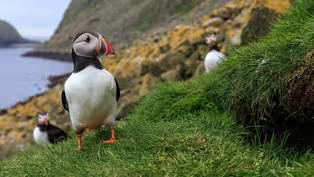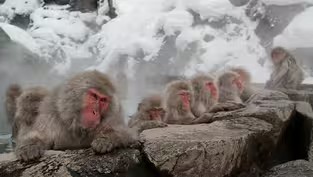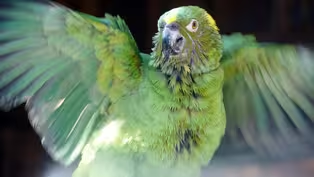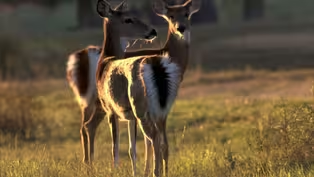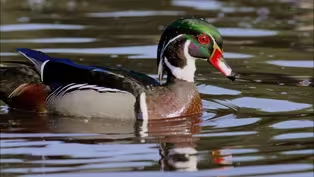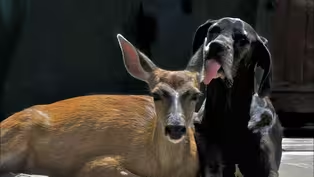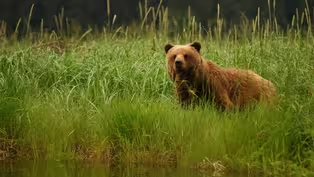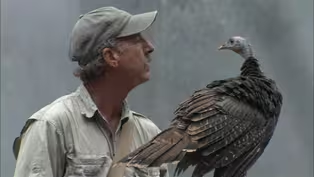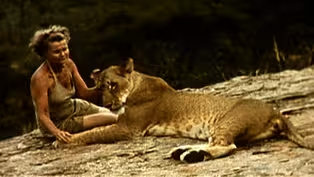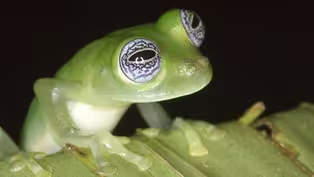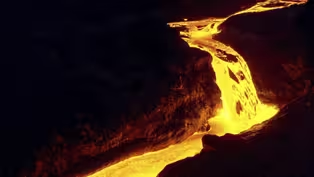
Grand Teton Wilderness
Season 9 Episode 35 | 50m 23sVideo has Closed Captions
The human and natural histories of the Grand Tetons and Jackson Hole, Wyoming
Filmmaker Wolfgang Bayer, who lives in the Grand Tetons in Wyoming, explores their moods from cold and forbidding to richly colored and full of light. This fierce beauty has influenced many lives, from trappers to conservationists.
Problems playing video? | Closed Captioning Feedback
Problems playing video? | Closed Captioning Feedback
Major support for NATURE is provided by The Arnhold Family in memory of Henry and Clarisse Arnhold, Sue and Edgar Wachenheim III, The Fairweather Foundation, Charles Rosenblum, Kathy Chiao and...

Grand Teton Wilderness
Season 9 Episode 35 | 50m 23sVideo has Closed Captions
Filmmaker Wolfgang Bayer, who lives in the Grand Tetons in Wyoming, explores their moods from cold and forbidding to richly colored and full of light. This fierce beauty has influenced many lives, from trappers to conservationists.
Problems playing video? | Closed Captioning Feedback
How to Watch Nature
Nature is available to stream on pbs.org and the free PBS App, available on iPhone, Apple TV, Android TV, Android smartphones, Amazon Fire TV, Amazon Fire Tablet, Roku, Samsung Smart TV, and Vizio.
Buy Now
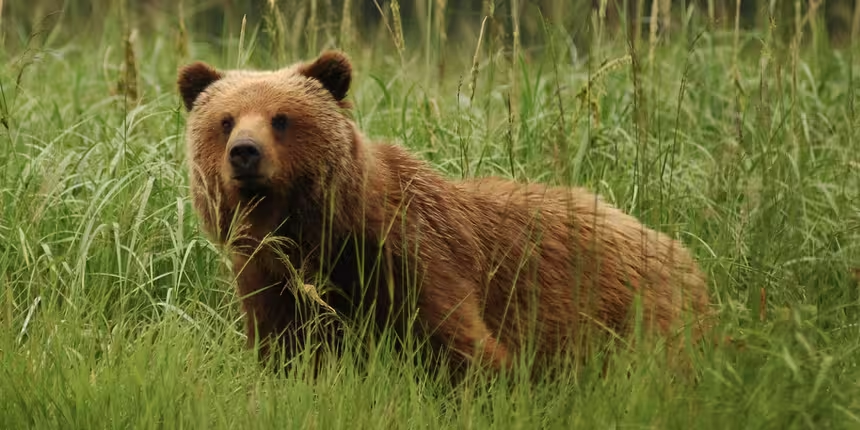
Explore More Ways to Watch
Bring the beauty and wonders of wildlife and natural history into your home with classic NATURE episodes.Providing Support for PBS.org
Learn Moreabout PBS online sponsorshipMore from This Collection
Watch classic NATURE episodes with the PBS station member benefit Passport.
Video has Closed Captions
Animals congregate in huge colonies partly out of necessity and partly for the security. (52m 55s)
Video has Closed Captions
Follow a troop of snow monkeys in Japan to see how they prepare to face the world. (52m 58s)
Video has Closed Captions
Parrots and the bittersweet world they share with humans. (53m 10s)
Video has Closed Captions
Learning about one of our closest neighbors: the white-tailed deer. (53m 10s)
Video has Closed Captions
Take a fascinating look at one of our most familiar birds. (1h 42s)
Video has Closed Captions
Love apparently knows no boundaries in the animal kingdom. (53m 20s)
Video has Closed Captions
Enter a world shaped by bears, trees, and salmon. (50m 9s)
Video has Closed Captions
One man's remarkable experience of raising a group of wild turkey hatchlings to adulthood. (58m 51s)
Elsa's Legacy: The Born Free Story
Video has Closed Captions
The true story that inspired "Born Free". (53m 10s)
Video has Closed Captions
It is the greatest mass extinction since the dinosaurs. (53m 43s)
Video has Closed Captions
Kilauea, on Hawaii's Big Island, is the world's most active volcano. (54m 6s)
Video has Closed Captions
Relationships with cats and dogs are some of the longest and most intimate of our lives. (53m 30s)
Providing Support for PBS.org
Learn Moreabout PBS online sponsorship- [Mardie] What if we could pretend or believe that some great spirit once upon a long time ago decided let's see how we can make a perfect valley?
[elk calling] [gentle music] - There are certain places in the American West that just naturally lend themselves to legend.
They're bigger, rougher, more dangerous, somehow more rewarding, and no place conjures up the romance of the frontier more than the chiseled peaks of the Grand Tetons and the valley of Jackson Hole.
Here in Wyoming, mountain men found beaver, elk, moose and bear and their tales of adventure fired the imagination of a young nation in the late 1800s.
Filmmaker Wolfgang Bayer, who lives here, explores these mountains in all their moods, from cold and forbidding to richly colored and full of light.
This fierce beauty has influenced many lives from trappers to conservationists.
Their stories make this place unique for unlike much of our West, people came here not to tame a wilderness, but to find a place in it.
[gentle music] We can only wonder at the tremendous forces that lifted these mountains from the earth and created this rugged landscape.
Born of bedrock and sculpted by ice, the Tetons are imposing sentinels of a spectacular and isolated valley; Jackson Hole.
It took 100,000 years of ice to shape this place and the incessant return of winter to keep it wild.
Winter lasts half the year, cloaking the mountains with deep snow and stunning cold.
[swans honking] [elk calling] The wildlife endures winter's trials because winter safeguards their wilderness.
Long after the surrounding territories were settled the fierce winters of the Tetons kept people at bay.
It wasn't until 1884 that homesteaders came to stay, a full 12 years after neighboring Yellowstone was made a national park.
But bison found a refuge here.
The land was not generous, but it was undisturbed.
Elk that retreated from the developing frontier also found a haven in the secluded valley.
The water is near freezing, but still 70 degrees warmer than the frigid air, creating a riverside blanket of warmth.
Abundant food brings moose to dense willow thickets along the Snake River.
The Snake River freezes over only in the most severe winter spells.
It provides an important feeding area for a number of creatures, including the river otter and the bald eagle.
As long as the river stays open, bald eagles remain in Jackson Hole, but on colder days, the ice-choked water can provide special challenges to fishing.
An immature bald eagle learns by watching.
Cold water and ice pose no problems for the dipper as it searches the rocky stream bed for aquatic insects.
Its nostrils close with a special flap and its warm, soft feathers are coated with an oily film that sheds the frigid water.
Even in the worst of winters the dippers need only a small patch of open river to survive.
Though severe, weather in the Tetons is fickle.
The first months of winter can be tentative, periodically warming and refreezing as if to get a better grip on the land.
[gentle music] At times, open water can be scarce and the few unfrozen ponds collect resident trumpeter swans.
Normally the swans live in small family groups.
In winter, they must share this limited feeding area and crowding triggers territorial aggression.
[swans honking] Trumpeting and head bobbing helped to reinforce the pair bonds of lifelong mates and the mood is infectious.
Only if the waterways freeze completely will the swans abandon their Jackson Hole territories to seek open water elsewhere.
As the last of the great glaciers melted, wildlife found a sanctuary by the Tetons, but they were not to be alone forever.
A new species began to forage in the valley.
Nomadic Indians, guided into Jackson Hole by the towering peaks, respectfully named them the Hoary-headed Fathers.
French trappers would rename them Les Trois Tetons, The Three Breasts.
Harsh winters prevented any permanent camps but several Indian tribes came to hunt and forage in the valley's summer bounty.
A shy band of Shoshones roamed the Tetons, eluding their aggressive neighbor tribes and hunting wild sheep.
With the coming of European explorers, Jackson Hole entered a new era, but the Indian's reverence for both the wildlife and the earth helped shape the future of the Tetons.
Their descendants married the mountain men and passed on their respect for the Teton wilderness.
A few hardy explorers and trappers followed the Indian trails into Jackson Hole, just as the western fur trade was developing.
This began the brief and romantic era of the mountain man.
John Colter claimed to have discovered Jackson Hole in 1807 and beaver soon lured other mountain men into the valley.
Jim Bridger, Jedediah Smith, and Kit Carson all came here to trap.
They call these high mountain valleys holes and named Jackson's Hole after trapper, Davy Jackson.
When beaver became scarce and the demand for hides fell, the mountain men disappeared, leaving only the wildlife and a few colorful names.
In the old days when mountain snows deepened and travel became too difficult, the mountain men followed the elk down into the valley.
Here the elk found water and food, but as winter progressed they were forced into smaller and smaller meadows and food became scarce.
Thousands could die in a hard winter.
On traditional wintering grounds, scavengers wait patiently for the elk to succumb to the hardships of the season.
When the elk die, coyotes prosper and they stay with a great herd all winter.
The old and the weak are the first to fall.
The coyotes gather in packs, not to hunt, but to clean the land.
They follow a strict social order at these feasts and the younger animals must wait submissively for their turn.
A fastidious coyote cleans his muzzle in fresh snow.
Just as the mountain men learned from the wildlife, the first settlers in Jackson Hole quickly found that the best ranching land was the wintering grounds of the elk.
Early residents staked their claims on prime summer meadows and each winter the elk encountered new obstacles.
The rich grasses that once fed vast herds was being harvested for cattle.
Drift fences guided the migrating elk away from the hayfields and ranchers eventually herded the elk into one area.
In 1912, Congress established a national elk refuge.
The US Biological Survey assigned biologist, Olaus Murie to study the Jackson Hole elk herd.
In 1927, Olaus and his wife Mardie moved with their family to the isolated town of Jackson, Wyoming.
The Muries would spend most of their lives here and their work would influence generations of naturalists.
The inspiration of Jackson Hole brought out Mardie Murie's desire to preserve the natural beauty around her.
Under the spell of the Tetons, she began her own career as a writer and an eloquent voice for conservation.
Recorded in a series of books, her observations of wildlife and people became classic reading.
Mardie remembers vividly the controversial early days of the Elk Refuge.
- I think in the early days the the ranchers were proud of having this big elk herd, and yet at the same time they had to be concerned about their own haystacks and the elk were certainly likely to get into those to quite an extent.
The thing about the elk was that they were dying off in the winters and people thought they were starving and some of the ranchers were trying to feed them and they were concerned when the elk seemed to be in trouble, and I think they were all concerned about the preservation of the Jackson Hole elk herd.
- [Narrator] To keep the elk away from the ranchers' haystacks, they were fed surplus hay purchased with state money and funds were provided to expand the size of the elk refuge.
This land was declared elk property and the citizens felt a special respect for the animals wintering in their backyards.
This was the spirit Mardie Murie found in Jackson when she arrived.
[soft music] - [Mardie] Well, we were living in the town of Jackson several winters, and in the town the roads were sort of plowed, there was always a pathway at least enough so you could walk.
No, people got around with sleighs, too, and quite a few people had horses that were the kind you would hitch up to a sleigh and and that's the way the doctor made his rounds.
I remember that.
There's always a way of devising ways of living.
I think we felt some isolation from other counties in Wyoming and from the country as a whole, so we were here to make the best of what was here for us.
- [Narrator] The six months of winter seemed forever to the snowbound pioneers of Jackson, but by April, warm winds from the outside world would breathe new life into the Tetons.
The rhythms of spring have begun.
New plant growth outlines the banks of the Snake and provides fresh browse.
Long before the mountains have shed their snow, waterfowl find their nesting sites on quiet streams and beaver ponds.
Spring in Jackson Hole is brief, but after such a long winter, its warmth is especially welcome, and life responds.
While spring gives way to summer in the valley, high up in the mountains, winter persists.
Deep beneath the mountain snows, the pika waits.
Related to rabbits and hares, the pika defends a small year-round territory of rocks and scattered patches of vegetation.
When spring finally arrives in the peaks, the marmot emerges from its long hibernation.
It has only two months to gain enough fat to sustain life for an extraordinary 10 months of dormancy.
With their vast winter accumulation of snow, the Tetons act as a huge storehouse, releasing water throughout the spring and summer.
Cycles of freezing at night and thawing during the day slow the loss of water from the peaks, but the steady downward flow continues to wear away the hard granite, a grain at a time.
Mineral-laden water from the melting snow forms rich cascading streams at the foot of the Tetons.
Nesting on a protected slab of a midstream boulder, the dipper is at home in the turbulent flow.
The adults feed in the racing stream, clinging to the bottom to find the larva of aquatic insects.
Young dippers are as immune to glacial water as their parents and will begin foraging for themselves soon after leaving the nest.
Water from the Tetons also brings to life a spectacular display of wild flowers.
On the lower slopes of the mountains, there are rich meadows where an endless array of blossoms color the short season, tracing the progression of spring.
On the valley floor fields of lupin mark the onset of summer.
This year's coyote pups are eager to explore their new world.
The young coyotes are taught to stay close to the den but their curious nature makes it hard to be patient while the adults hunt.
During past droughts, pronghorn antelope established migration roots into the mountains from the plains beyond.
In Jackson Hole, they found not only grass, but the open flatlands they prefer for bearing their young.
Odorless and nearly invisible, the newborn pronghorn seems to melt into the ground.
Within hours of birth, the fawn is up and within a day it's rejoicing in its own speed.
Pronghorns are the fastest animals in North America.
[gentle music] As spring reaches into the mountains, the elk herds leave their winter refuge and follow the melting snows up into the highlands.
Higher up, the elk find cooler temperatures and fewer biting insects.
Along the way, the cows reach their traditional calving grounds to give birth in late May.
This is the time when the calves are most vulnerable to predation by bears and other large predators.
The black bear can become a voracious hunter of newborn elk, but it isn't fast enough to catch the calves in the open meadows.
Only by surprise can the black bear be a serious threat to elk.
Following trails used for hundreds of years, the elk teach a new generation how to negotiate the Teton landscape.
Unknowingly, they follow patterns of food and water determined by the underlying geology.
The Teton Range is the youngest of the Rocky Mountains.
They emerged only 9 million years ago when a fault formed between two huge blocks of the earth's crust.
In a series of jarring earthquakes, one block tilted up to form the abrupt face of the Tetons.
The other tilted down to create Jackson Hole.
The combined movement was an amazing 30,000 vertical feet, with most of the movement occurring on the side that dropped to form the valley.
Receding glaciers later filled the deep valley with loose rock, leaving a flat plain to accentuate the stark peaks.
High in the protective cold of the peaks, a dozen small glaciers still work the sites of the ancient ice flows, transporting and piling up rock into moraines.
The large glaciers that carve the distinct U-shaped canyons through the Tetons deposited their moraines at the valley floor to create a corresponding series of reflective lakes.
The massive glaciers withdrew from the Tetons 12,000 years ago to reveal a raw and broken land.
High in the rocky peaks, there has been little change since then.
There are animals here, but their populations are small.
[marmot squeaking] The hardy marmot and the pika, with its fur-covered feet and stockpiles of food, managed to make a home in the seemingly bare rock.
At 11,000 feet, there are few insects and the vibrant colors of the mountain heath must attract solitary bees for pollination.
Though they're bright, the flowers are not showy and to avoid the wind, most grow in dense protected mats close to the ground.
Vegetation here is sparse, but there is enough food to support the ravenous appetite of the marmots.
They feed furiously for these few weeks of alpine summer.
The vegetation that's not consumed is carried back to the marmot's rocky den to line the nest.
This burst of activity allows the marmot to sleep away most of its life.
It took thousands of years of glaciers and erosion to sculpt the Tetons and centuries more for life to find a delicate foothold.
Yet for all their strength and isolation, the Tetons remain a fragile beauty.
In 1929, the magnificent mountains and their jeweled lakes were set aside as a national park.
[gentle music] Now the Tetons would remain forever much as the mountain men had left them.
Today, two and a half million people pass through Jackson Hole each year.
Despite growing numbers of visitors, there is still a spirit of respect for land and wildlife that makes it possible to experience wild animals in their own domain.
Travelers come here now to capture for themselves the feelings of Native Americans or early explorers upon seeing these impressive sights for the first time.
Where the Shoshone Indians traveled to harvest and gather for their survival, tourists now arrive for recreation.
In 1950, an act of Congress expanded the park to include the entire north end of Jackson Hole.
Many homes were incorporated into the park, among them the log cabin of Mardie Murie.
Mardie continues to speak out for wildlife conservation.
Her perspective of Jackson Hole history is as unique as the view from her front porch.
- The place was rich in wildlife and happily I think it still is because the people do really think about it a lot.
We found that while supposedly camped at the head of Arizona Creek, a bear might amble through in front of the cabin, a coyote would be howling in the middle of the night maybe.
We found that there were other animals sharing the range with the elk, like the mule deer in some parts, and wonderful animals like otters that if you could sneak up and watch them diving around and playing in the water.
I think the wildlife, for whatever reasons, is as plentiful today as it was then, which is a cheerful note.
The wildlife has been considered very kindly by all the people who live in the valley.
- [Narrator] Kindly consideration came nearly too late for the American bison.
The last great herds were massacred on the western plains in the 1800s, and by 1840 they were gone from Jackson Hole.
20 bison from Yellowstone were brought to the Tetons in 1948.
They were protected in a 700-acre enclosure, but disease slowly took its toll.
In 1968, the last 15 bison escaped their confinement and six more died in attempts to recapture them.
Finally, the remnants of the herd were allowed to run wild.
Today there are more than 100 healthy animals.
As symbolic as the mountain man or the covered wagon in America's frontier history, the free-roaming bison of the Tetons are a living reminder of Jackson Hole's colorful past.
[gentle music] By late summer, snow pack in the Tetons is the last source of moisture.
Each morning the sun warms the mountain air and draws out clouds of evaporation, but the scant moisture soon wisps away into parched Wyoming air.
[thunder rumbling] Thunderstorms bring little rain, but do carry the threat of lightning and wildfire.
Lightning finds a lodgepole pine and flames quickly spread through the dry limbs.
An age-old process of renewal by fire has begun.
The stark geology of Jackson Hole limits the range of forest growth and the fire dies from lack of fuel at the top of a barren ridge.
The smokey ruins seem lifeless, but these recurring fires burn lightly, leaving and tack the seeds for regeneration.
The forest will grow back and in the process go through a succession of plant species that will support a greater diversity of wildlife.
Water continues to flow and new life quickly sprouts along the moist banks.
Not all natural changes are as dramatic as fire.
By damning streams and cutting trees for food, the beaver becomes an architect of its stream-side habitat.
By harvesting aspens and willows, the beavers change a forest into a pond.
The lodge where the young are born and raised is a marvel of design.
Built of thick limbs and packed mud, the only entry is through underwater channels.
Inside, on a raised platform, the family stays warm and dry.
The beavers eat fresh bark and leaves all summer, and as fall approaches they will begin to store tree limbs underwater.
With food caches nearby and a network of channels into surrounding willows, the beaver will be prepared for the six months of winter ahead.
By damming enough water for its own protection, the beaver makes a new habitat for other Jackson Hole wildlife.
Aquatic plants take root in the beavers' pond and fish soon appear from upstream.
Trout may grow to considerable size if the pond is large enough.
After a winter subsisting on tough willow limbs, this enterprising moose has found that the tenderest plants are growing under six feet of water.
The moose calf learns from its mother what plants to eat, but it hesitates to follow her into deep water.
The dam requires constant upkeep to maintain a safe water level.
The beaver is stimulated to begin repairs by the sound of running water and arrives to patch a break.
Occasionally during spring flood waters even the strongest dam gives way.
As the break widens, water is draining too rapidly to be stopped.
Within hours, the dam will be beyond repair.
The exposed lodge is abandoned and in time decays and blends into the earth.
The dried beaver pond, once home for waterfowl and trout, sprouts grasses and gradually turns into a lush meadow.
[gentle music] Only time can reveal the subtle changes of the natural world.
Mardie Murie has spent a lifetime observing these gradual transformations.
- [Mardie] Natural rhythm, especially in a valley like this, is something that perhaps most people don't think about, but it shouldn't be ignored, it's an interesting thing to know about.
And I'm sure that there is a rhythm and a certain piece of land carrying certain kinds of trees and then something happens to those and another species comes in and this goes on and on and if people could understand that a little more, they might not be so fast to just savagely clear land, and things like that we need to learn, especially if we're gonna live in a valley like this, where you can see these things happening almost day by day.
- [Narrator] With the coming of autumn, the rhythms of the valley turn to a brisker pace.
It's a time of change and preparation and the Tetons reflect a new mood into Jackson Hole.
As they have for hundreds of years, the elk respond to autumn in the Tetons with their annual mating rituals.
In the frosty chill of dawn a bull gathers his harem of cows and calves.
His bugling call claims this herd as his own and challenges other bulls to respond.
Practicing their technique, two young bulls prepare for the challenge but it will be another season before they're ready to fight.
[elk bugling] Quiet settles over the Tetons.
For many this is the turning point when those who migrate must leave the valley or risk being trapped by snow.
Winter is moving in on fresh winds.
Cold air draws the last warm breath of fog from the canyons and soon the first snow drifts over the Tetons and into Jackson Hole.
With a last friendly spar to end the fierce battles of their breeding season, bull moose move to their winter range.
By late winter, their antlers will drop, and in spring new ones will grow.
The pronghorns leave Jackson Hole for their winter range on the dry plains to the south.
[gentle music] With its thick winter coat for warmth, the coyote patiently settles in for the long, lean months ahead.
Snow sends the last sandhill cranes on their long flight south to New Mexico.
Winter returns and once more, a hint of the ice age touches the valley.
Deepening snow drives the elk out of the mountains.
From as far as Yellowstone 60 miles away they will follow traditional paths to a more certain winter on the elk refuge.
The refuge shelters the elk from human encroachment, but where winter habitat borders civilization, wildlife must coexist with people.
Mule deer seek easier foraging in the lowlands and some find it in the sheltered town of Jackson.
In the early 1900s, the practice of feeding and caring for the Jackson Hole elk herd was established and it continues today.
Three-fourths of the elks' historic winter range has been developed and feeding is now necessary to prevent starvation.
When the elk leave Grand Teton and Yellowstone parks, they enter a less natural but more charitable world.
They're fed daily through the worst months of winter and quickly adjust to the horse-drawn sleighs with their promise of hay.
[elk vocalizing] This curious blend of the wild and the civilized has been a trait of Jackson Hole since its discovery.
Here humankind came late and listened to the wisdom and the history of the mountains.
In the grandeur of the Tetons, the wild frontier of the American West seems to linger, held deep in the land and in the heart.
After a lifetime under the spell of the Tetons, perhaps Mardie Murie knows why.
- [Mardie] What if we could pretend or believe that some great spirit once upon a long time ago decided let's see how we can make a perfect valley?
We would need mountains to begin with and then we would need some flatlands to show off the mountains and certainly we would need some water running through, there would have to be a river.
And on the side at the feet of the mountains, there would have to be lakes, maybe more than one or two or three.
All these things would go together to make a perfect valley.
I think the spirits are here.
I think they've done as good a job as anything could do.
I can't think of any basic thing that I would change if I had the power to change it.
[gentle music] [intense tones]

- Science and Nature

Explore scientific discoveries on television's most acclaimed science documentary series.













Support for PBS provided by:
Major support for NATURE is provided by The Arnhold Family in memory of Henry and Clarisse Arnhold, Sue and Edgar Wachenheim III, The Fairweather Foundation, Charles Rosenblum, Kathy Chiao and...
